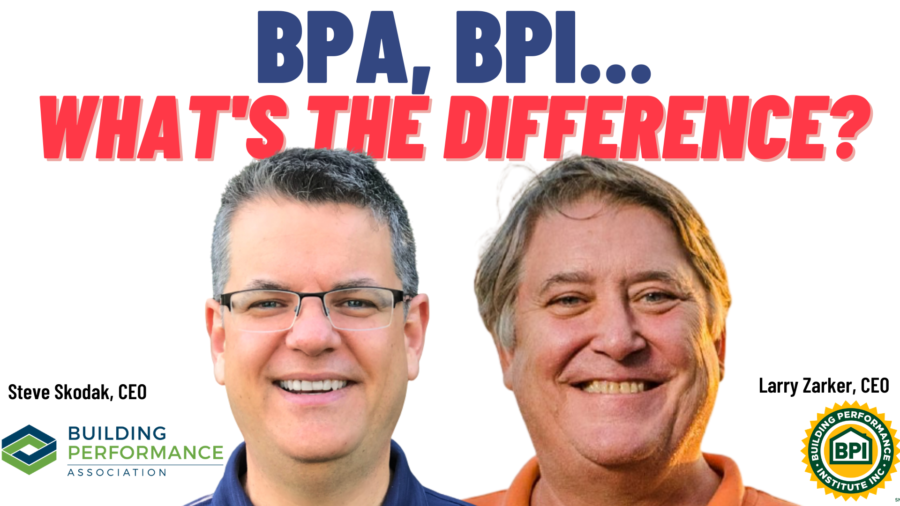Mar 16, 2021
BPA, BPI…What’s The Difference?
An interview with Steve Skodak and Larry Zarker sheds light on the differences between BPA and BPI.
By: Macie Melendez

The home and building performance industry is one filled with acronyms. When completing an energy audit or assessment on a home, a HP (home performance) contractor uses a blower door test. Results from that test give you numbers in ACH (air changes per hour) and CFM (cubic feet per minute). During that same audit, a contractor may also need to know the home’s CFA (conditioned floor area) or test the IAQ (indoor air quality). But EE (energy efficiency) also relies upon factors such as HDD (heating degree days), CDD (cooling degree days), and RH (relative humidity).
But wait, what’s the HVAC (heating, ventilating, and air conditioning) system like? Does the home use CFLs (compact fluorescent light) or LEDs (light emitting diode)? There may be some holes that need to be filled to help save energy—a professional may suggest the use of SPF (spray polyurethane foam) or a SIP (structural insulated panel). That contractor may be a member of BPA (Building Performance Association), hold a certification from BPI (Building Performance Institute), and be working for HPwES (Home Performance with ENERGY STAR program) or WAP (Weatherization Assistance Program).
If you’re reading this, you’re probably familiar with these acronyms. Or maybe you’ve written them down on a Post-it note next to your computer like I did when I first started editing a trade magazine in this industry a decade ago.
Now, as a member of the BPA team, it’s become very clear that some acronyms still need clarification. The fact of the matter is that a lot of people in our industry get BPA and BPI confused for one another. But, they are in fact, two separate organizations.
In an effort to clear some things up, I spoke directly to the source: the CEOs (Chief Executive Officers!) of both BPA and BPI. Let’s hear what they have to say.
The Basics
Q: What does the acronym BPA stand for?
Steve Skodak (SS), CEO, BPA: The Building Performance Association.
Q: What does the acronym BPI stand for?
Larry Zarker (LZ), CEO, BPI: The Building Performance Institute.
Q: What does BPA do?
SS: The BPA mission is to advance a thriving industry that delivers improved energy efficiency, health, and environmental performance of buildings. The association is devoted to enhancing the workforce development of its members by creating educational opportunities that establish a culture of ongoing learning. We are committed to redefining the industry by supporting policies that will improve and increase the expansion of home and building performance, energy efficiency businesses, and industries.
Q: What does BPI do?
LZ: BPI is 501 c3 national non-profit organization that sets standards and certifies the workforce to upgrade the comfort, health, safety, durability, and energy efficiency of the nation’s 134 million existing homes. BPI also accredits contractors to ensure a commitment to quality workmanship and continuous improvement in the delivery of retrofit work. BPI is accredited by the ANSI (American National Standards Institute) as a SDO (Standards Development Organization) and is also accredited by ANSI under ISO 17024 as a professional certification body.
Frequently Asked Questions
Since the BPA team gets questions about BPI on a regular basis, let’s answer some of the most common questions we receive.
Q: Didn’t BPA used to be BPI? Didn’t the two organizations merge?
SS: BPA is a separate organization. We have never been a part of BPI and have not merged. BPA is the association that works to promote the industry, provide opportunities for ongoing dialog by hosting conferences and trade shows, and advocating for the industry. BPI provides credentialing and industry standards for those performing the work in our industry.
Q: Aren’t BPI and BPA the same organization?
LZ: No, BPI helped start the Association working in tandem with key stakeholders focused on consolidating several separate non-profit organizations (e.g., Home Energy magazine, Efficiency First, and the Home Performance Coalition) into a vibrant industry association serving the entire home performance retrofit market. In fact, BPI offered to include its entire network of over 10,000 certified professionals, GoldStar contractors, Test Centers, and Proctors into the first-year membership of the Association.
Q: I’m a BPI Certified Pro/Goldstar Contractor, so doesn’t that make me a BPA member?
SS: It does indicate that you are at the top of your field; however, does not automatically make you a BPA member. BPA membership provides an additional level of support to these contractors. BPA is a tireless advocator for local and national policy that benefits the industry as a whole. Being a member provides BPA with the support needed to enable us to develop programs, events, educational materials, and support for many areas of their business.
Q: Do I need to be a BPA member to keep my BPI certification active?
LZ: BPI does not require but does actively promote membership in the Association. As a non-profit, standards setting and certifying body, BPI cannot engage in lobbying on behalf of members whereas that is a primary responsibility of the Association. BPI depends on the Association to promote BPI standards and certifications in state and utility programs across the country. We view this as a mutually beneficial, symbiotic relationship.
Practical Information
Now that we’ve cleared that up, let’s share some practical information.
Q: Does BPI work together with BPA at all?
SS: We do work closely together. We maintain a few board members that serve on both boards. Both Larry and I serve as ex-officio members of each other’s board as a way to better understand the goal and objectives of key strategies. We also bring our senior management teams together regularly to update one another on ways to better serve our industry and cross promote.
Q: What is the biggest distinction between BPA and BPI?
LZ: BPA is a membership organization dedicated to improving the market for the work that its members conduct or sell products into. As an industry association, BPA represents all aspects of the industry engaged in improving the performance of the nation’s housing stock. BPI focuses on the workers and companies engaged in this work to ensure that they have the knowledge, skills, and abilities to do the work effectively and the company-level commitment to deliver quality upgrades for its customers.
Q: Who should people contact if they have certification questions?
LZ: BPI’s Director of Operations is Lynn Griffith. She can be reached at lgriffith@bpi.org.
Q: Who should people contact if they have membership questions?
SS: Robyn Hall, our Customer Service Manager at rhall@building-performance.org.






